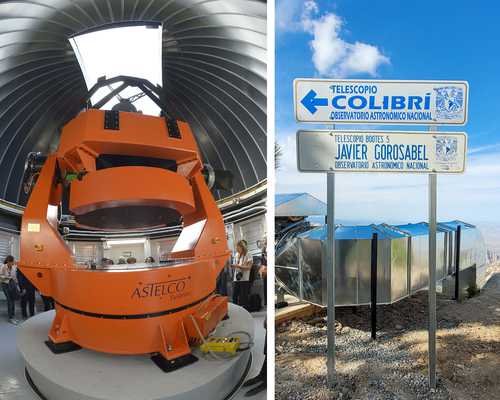A few days after being installed, the telescope hummingbirdlocated at the National Astronomical Observatory in the San Pedro Mártir mountain range, received the first alert to observe a gamma ray burst, one of the most energetic cosmic events in the universe since the big bang.
It was very exciting because as soon as the alert was received, the dome of the building that houses it had to rotate and open in 20 seconds to be able to detect the explosion and follow it for three and a half hours.
said Rosalía Langarica Lebre, researcher at the Instrumentation Department of the Astronomy Institute of the National Autonomous University of Mexico (UNAM) and involved in the development of the instrument.
In interview with The Dayhighlighted that although at that time it was not possible to collect more data about the explosion, because the peripheral instrumentation that would allow the data to be analyzed had not yet been installed, it was possible to verify that the telescope does respond to the alerts and that it is in coordination with the building that houses it.
The device was built through a collaboration between Mexico (UNAM Institute of Astronomy and National Council of Humanities, Sciences and Technologies) and France (the universities of Aix-Marseille, Toulouse, and Alpes-Grenoble, as well as the National Center for Space Studies and the National Center for Scientific Research).
Its main objective is to identify and track gamma ray bursts, an area of astrophysics study that deals with one of the events that release the most energy in the universe.
Outbursts are related to the final stages of a star’s life and a lot of energy is released at these times; as much as the equivalent of all the force that the Sun releases in its entire life, with the difference that the bursts occur in a few seconds
commented the expert.
He added that his study is of utmost relevance because this explosion generates extreme conditions – which cannot be reproduced on Earth – through which it is possible to study the behavior of matter.
We must keep in mind that all the elements that are in the periodic table are formed there. Everything comes from the stars. Therefore, the knowledge we obtain from observing it is essential.
hummingbird will network with two other ground-based telescopes in China that will receive alerts from the Franco-Chinese satellite ALL (space-based multi-band astronomical variable object monitor) launched in June this year.
Having observation instruments in these two countries will always allow you to look at the sky from the part of the Earth where you are at night, regardless of its rotation movement.
he highlighted.
Langarica Lebre explained that he takes the name of hummingbird because it was built with a mechanical body that allows it to rotate quickly and go to any area of the sky in 20 seconds. It is 1.3 meters in diameter in its main optics and four meters high.
The optical design was done in Mexico, the mechanical structure in Germany and the mirror polishing in France, while the electronics and control were developed in Mexico and France.
Installed in the San Pedro Mártir National Astronomical Observatory, at 2,800 meters high, it has an instrument called DDrago, which allows it to analyze the light captured and convert it into information.
There is the idea, to this day, that astronomers work with one eye glued to the telescope; That has not been the case for many years. Due to the low levels of light that are detected, technical equipment is necessary that takes the collected light through an optical system that manages it in a certain way to finally carry out the analysis of the data that has been obtained.
The initiative was led by Stéphane Basa, researcher responsible for France, while William Lee was in charge of Mexico.
Langarica Lebre said that the first ideas of a collaboration to carry out this project date back 15 years, although the development began 10 years ago, and the definition and manufacturing have been going on for five years.
“hummingbird “It is a great technological achievement, but also an example of collaboration between scientists from different countries.”
